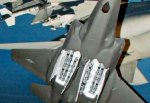Humor me if you have time. You insist amca is deliberately limited so that iaf can later import fgfa.
But wasn't that always the case? We were already working on two programs fgfa with Russia and amca on our own. Infact amca has medium in its name it was never supposed to be in heavy category like fgfa or f22! So even if amca internal payload was improved in design ( to 2ton+ instead of 1.5 ton claimed now) still it didn't threaten fgfa.
It was so in the beginning, when FGFA and AMCA were supposed to be two complementary programs. But the AMCA specs have changed since then to become as advanced as possible. So it turned from a passable next gen aircraft (Rafale++) into a true next gen aircraft (F-22++).
What cancelled fgfa was Russian delays and Russian refusal to share more work afaik. So if the original scheme of things was to have both fgfa and amca then how does your theory that amca design is sabotaged to secure fgfa hold true?
What actually killed FGFA was DRDO's claim that AMCA will be enough.
Because if Russian were on time with fgfa and offered more work to India we will still be running both programs and amca would still have same internal bay capacity! No? Please explain.
The IAF wanted to enter a JV program with Russia for two reasons. One was to get the capability, obviously, and the other was to help the Indian industry make headway into the next gen. That's also why AMCA was a much more simpler design in the beginning. Later they realised Indian industry under HAL was incapable of delivering even the 25% workshare as promised, which is obvious since only DRDO has developed the capabilities to contribute to the program. So when DRDO was approached, they said they have the technology to develop such an aircraft inhouse. AMCA's design itself went through many iterations since the beginning of the decade to what it has become today.
Anyway, AMCA has been designed as a system of systems. What it really means is if more and heavier weapons are necessary, the AMCA doesn't need to carry it by itself, all it needs is enough air defence missiles, and the rest can come from drones and other aircraft. For example, a winged drone can carry 4 missiles and/or some types of bombs that can help the AMCA accomplish missions that it cannot do by itself, especially missions which are extremely dangerous with low chances of survival. Future drones will even be able to take over dogfighting. Dropping a 2000lb bomb can be very risky business, because the type of target that requires a 2000lb bomb is a very dangerous target, and this danger can be passed on to a drone that's specifically designed to drop such a bomb, like the Ghatak. Considering all this, AMCA's IWB is fine. AMCA has been specifically designed to make use all next gen capabilities to the minimum, thereby removing the need for FGFA altogether.
Right now, considering the aircraft alone as a unit, the AMCA lacks swing role capability just like the F-35 (a ridiculously huge drawback for an aircraft that's been designed as an air superiority aircraft), and low internal and external payload (which is actually not such a big problem versus the swing role capability). The difference between having and not having swing role capability is ridiculously large that the AMCA is incapable of escorting itself, just like the Jaguar.
AMCA has been designed to be far superior to the F-22 in terms of stealth and performance. But...
Read this:
More Ambiguous F-35 Remarks by USAF's Gen. Hostage
In fact, Hostage says that it takes eight F-35s to do what two F-22s can handle.
Let this statement sink in, and then ask yourself this. Why does an aircraft as good or better than the F-22 have a payload that's worse than the F-35?


